Long ago, the simplicity of pulling out the wok for a quick stir fry became my go-to dinner plan for busy weeknight suppers.
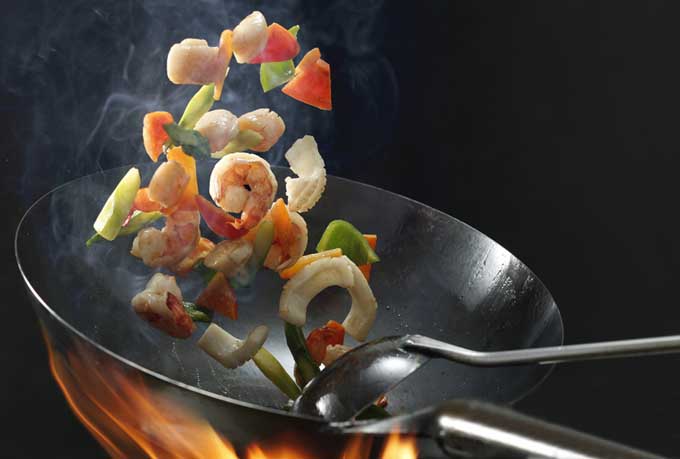
It’s the best method when there’s no plan in place, a bunch of different ingredients in the fridge, and less-than-no-time to pull dinner together and have it on the table. Both preparation and cooking times are quick, and cleanup is simple and easy as well.
It’s also an ideal way to take advantage of spring and summer produce – veggies turn out bright and crunchy, and retain most of their nutritional value. And if you keep a bag of frozen prawns, some chicken breast or inexpensive steak on hand in the freezer, adding protein to this dish is a breeze.
So, let’s look at some stir fry and wok basics – cooking methods, preparation, and a couple of recipes to test out.
Selection
For home use, woks come in a variety of sizes from 12 to 18 inches. One that measures 14 inches in diameter is big enough for most families, as this gives plenty of room for all of the ingredients, and the tumbling/tossing action of stir frying.
For most Western hobs and ranges, you should choose a pan that has a flat bottom to maximize the surface area that sits on the burner. This is important in order to transfer the heat up the sides, to optimize use of the entire cooking surface. Pans that have a curved bottom will lose this heat transfer. The result will be a small hot spot on the bottom and cool sides, which means some pieces will be overcooked and some undercooked… not the best results.
The traditional material of choice is carbon steel. It conducts heat efficiently, is safe for all food types, and once adequately seasoned, will form a natural nonstick surface.
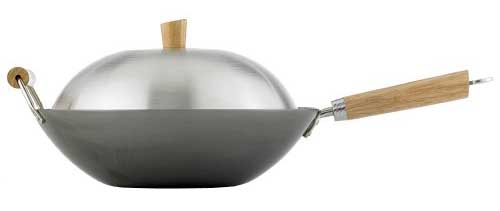
Helen Chen’s Asian Kitchen 14-inch Carbon Steel Flat Bottom Lidded Wok would be a great set to start with.
Other choices are similar to those found in skillets to include cast iron, multi-ply, ceramic coated aluminum, ones with nonstick treatments, electric and even bronze.
But, just a reminder: most nonstick coatings break down in the high heat required for stir frying, so you may want to rethink that particular choice.
The beauty of this versatile pan is its design. The broad, wide surface allows for quick reduction of liquids; the deep, half-moon shape with sloping walls is ideal for stir frying and steaming; and its well-like bottom transfers intense heat into the sides to create a large cooking surface.
A Note on Round Bottomed Woks and the Stoves That They Should Be Used On

The traditional Chinese wok is round bottomed. This works better for stir frying by allowing you to easily slide the ingredients up and out of the heat as they reach their desired state.
However, there is a catch: Western stoves do not get nearly hot enough to pass enough heat to the wok. Chinese households, as well as Chinese and Asian restaurants, often have purpose-built stoves that put out an excess of 30,000 BTUs, whereas your average residential hob barely gets to 10,000 BTU.
Moreover, these purpose-built stoves also have round inserts that allow these round bottomed vessels to get as close to the heat source as possible.
Camp Chef Expedition 3X 3 Burner Stove
So what’s the fix?
Either stick with a flat bottomed wok, or if you’re really into stir frying, you can invest in a good camp stove such as theCamp Chef Expedition (or one of the smaller 2-burner versions) that reaches 30,000 BTU (these are also excellent for home canning – they take the heat out of the house and there are no worries about cracked glass tops or other damage to your kitchen stove). You could then go with a round bottomed model and wok ring.
This will allow you to reach (and maintain) the correct temperatures. The round bottom and sides will allow you to fine tune the heat going to the food, by moving the ingredients to different parts of the pan.
Another option for those who are crazy about stir fry would be to keep the flat bottomed pan and upgrade to an induction stove. These will also reach an equivalent of 30,000 BTU, plus they will save you energy, they are super easy to clean, and they are nearly as adjustable and responsive as gas.
Read Foodal’s Wok Buying Guide for more details on what to look for when making your purchase.
Seasoning
Before using a new carbon steel or cast iron wok for the first time, you’ll want to season it to form a protective, nonstick and rust resistant surface – much like you would with cast iron cookware.
Here’s a traditional Chinese method:
- Thoroughly scrub with a soapy steel wool pad and hot water to remove the factory finish and machine oil, then dry completely.
- Thinly slice ½ cup of ginger root, slice 1 bunch of green onions into 2” pieces, and smash 1 clove of garlic.
- Heat the wok over high heat. Add 3 tablespoons of cooking oil and the ginger, onions and garlic.
- Reduce heat to medium and stir fry for about 15 minutes. Ensure that you firmly press the ginger, onion and garlic into the entire surface, as they’ll absorb any metallic taste from the steel while the oil coats the porous metal. This creates the first “patina” which, as it builds with time and use, is what forms the nonstick surface.
- Rinse with hot water and wipe with a soft cloth, then dry with a tea towel.
If you have a carbon steel wok that’s not used frequently, you may find it beneficial to give it a light re-seasoning after each use to prevent rust. To re-season, follow the steps in the “For clean-up…” point, found under the heading Basic Stir Fry Tips below.
For Stir Frying
A wok’s concave shape heats first in the bottom or well, then quickly transfers to the flared sides, developing intense heat on all surfaces. This creates a generous working surface, as both the sides and bottom are used to quickly sear and cook ingredients with just a fraction of the oil used in other pans.
- As with cast iron cookware, always heat your wok first before adding oil. This prevents food from sticking to the surface and quickly seals in flavor and juices. If you’re not sure about the temperature, add a drop of water to do a sizzle test first.
- Keep your wok as hot as possible. The wonderful flavors of a stir fry come from the interaction of the hot, oiled pan with the ingredients. Steamed foods and fried foods have very different flavors, so remember to fry with high heat.
- Have all ingredients prepped and ready to go. A stir fry happens fast, and you don’t want to hold up the process by searching for bits and pieces. Line up everything you’ll need on the counter next to your stove top to keep it moving, and time other dishes like rice and noodles to be ready at the same time.
- Add just a couple of drops of oil to start. If it smokes like crazy, let your pan cool down a bit before adding the rest. A small puff of smoke is to be expected, but not voluminous clouds.
- Add foods of similar texture and density together, but don’t over crowd the surface by adding too much at once. This will cause the pan temperature to drop quickly, releasing moisture instead of sealing it in – which then results in food steaming or boiling instead of the desired quick, hot searing.
- Use a thin metal spatula or chuan for stir frying, to get under the ingredients for the tossing motion required.
The Stir Fry Action
1. Always heat the wok before adding any oil – use the water drop sizzle test to determine if it’s ready. Don’t pour the oil into the well. Instead, pour lightly along the hot sides, rolling and swirling the pan to coat the entire surface.

2. Stir in the most intensely flavored ingredients first – garlic, ginger, onions and chili peppers. These are known as the “aromatics,” and their deep tastes will infuse the oil, adding robust flavor and fragrance to the dish.
3. Once the aromatics are lightly browned, push them up and out of the way a bit, and then add the protein. In a single layer, add your seafood, tofu, meat or chicken, and let it sit for a moment to sear. Toss and stir fry until they’re almost cooked, but not completely. Transfer all ingredients to a bowl.
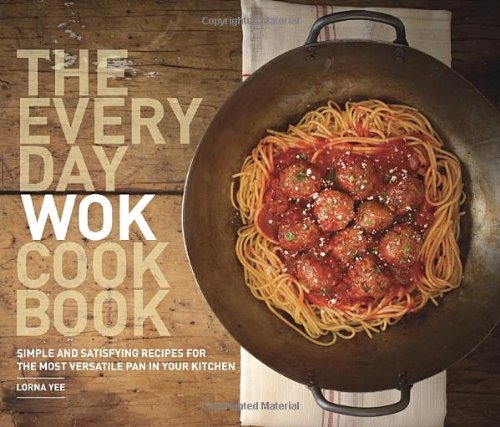
Foodal highly recommends The Everyday Wok Cookbook: Simple and Satisfying Recipes for the Most Versatile Pan in Your Kitchen
4. Add the vegetables according to their hardness and cooking times, with those requiring longer times going in first. Veggies such as carrots, broccoli and cauliflower should be added first, followed by medium density veggies like peppers, mushrooms, asparagus, celery and zucchini. Finish up with the most tender vegetables, like leafy greens, sprouts and tomatoes.
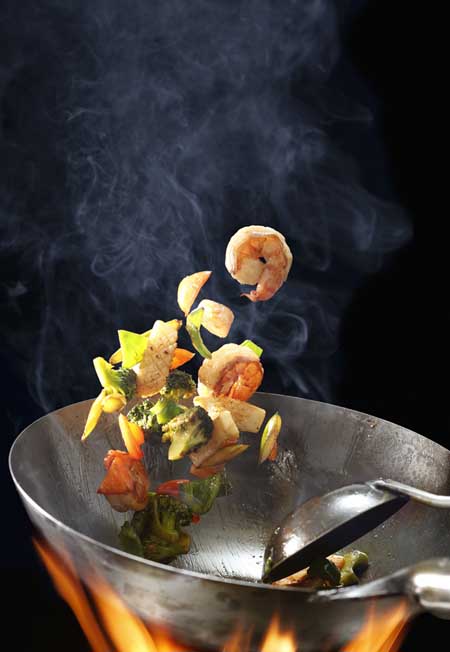
5.Toss using the stir fry action. With a quick motion, slide a thin spatula under the food to constantly roll it over on itself.
6. Deglaze the pan with a liquid such as soy sauce, stock, broth, rice wine, or coconut milk, by drizzling it down the sides. Return the protein and aromatics to the pan, and quickly toss to re-heat all ingredients. Check out Foodal’s Guide to Searing for more information on deglazing.
Basic Stir Fry Tips
- Use oils with a high smoke point that can take high heat without burning. The best candidates for stir frying are: safflower, light refined olive oil, and peanut. Sesame oil is also used quite a bit throughout eastern Asia for it’s wonderful flavor – it’s often added towards the end of cooking, so as not to change its unique taste.
- Cut all ingredients into pieces of the same size for even cooking.
- You can give veggies that require a longer cooking time – such as carrots, winter squash, broccoli and cauliflower – a bit of a head start with a quick blanching before stir-frying.
- Slice meat and poultry thinly across the grain for quick cooking and tenderness, but slice fish along (or with) the grain.
- Ensure that all of your ingredients are well drained – pat all veggies, scallops, shrimp, etc. dry with a paper towel before adding to the wok, so they sear instead of steaming.
- Add a drop of water to your heated wok before cooking. If it sizzles, you’ll know it’s hot enough to cook with.
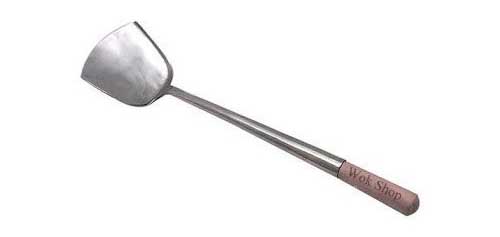
- Use a thin metal flipper or a stir fry chuan (spatula) with lipped sides to improve the quick, stir fry motion, and to get between the ingredients and the pan.
- For cleanup, wash your wok with hot water, a drop of soap and a soft cloth. If you have to scour, re-season lightly after drying. Barely heat your pan to medium high, remove from heat and add a drop of oil, then rub it into the entire cooking surface with a paper towel. And be careful not to burn your fingers – it will be hot!
- A better alternative to scouring, which will remove the patina created by seasoning, is to clean with a salt scrub. Heat the pan to medium high, remove from heat, and add 2 tablespoons salt and 1 tablespoon of oil. Wad up some paper towels and thoroughly rub the salt mixture over the surface to remove any stuck-on bits of food.
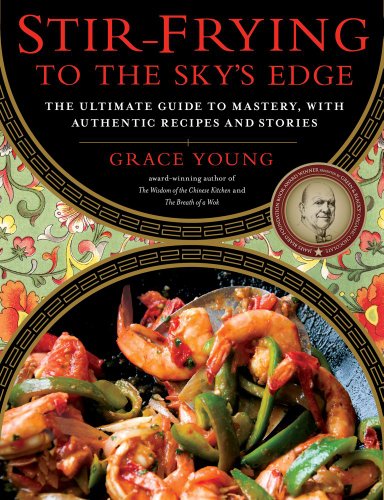
Foodal recommends Stir-Frying to the Sky’s Edge: The Ultimate Guide to Mastery, with Authentic Recipes and Stories available in hard cover, paperback, Kindle and other formats.
For Steaming
The circular and concave shape of a wok makes it the ideal vessel for using a traditional Chinese bamboo steamer insert. One of the perks of using a bamboo steamer is that the fibrous lid will absorb excess moisture, instead of having the condensation drip back down on the ingredients.

Foodal recommends the Joyce Chen 26-0013, 10-Inch Bamboo Steamer Set available on Amazon.
However, a metal steaming rack works well too. You can get one with hooks for hanging over the edge of the wok, or use a standard metal steamer basket with legs.
- Bring whatever liquid is being used for steaming to a boil before adding food, like buns or vegetables, to the steamer.
- Use long handled tongs for adding and removing food. Steam is very hot, and burns on the forearms and hands can happen quickly.
- When finished steaming, you may notice a “water line” in your wok where the seasoning has been steam-cleaned from the surface. If this happens, just re-season as outlined above.
For Deep Frying
Deep-frying small pieces of tempura with a wok works very well, due to its unique shape – the narrow bottom and sides that increase in diameter from bottom to top means less oil is needed than for a regular pot. As a result, you can fry more food in each batch, with the pieces sitting on the surface of the oil without overcrowding.
- Always use a type of oil with a higher smoke point.
- 2 inches of oil will usually be sufficient for deep frying, but never fill to more than about one half capacity, as the pan will start to get top heavy.
- Use a thermometer designed for deep fryers, to check the oil temperature before adding food.
- Ensure that all of your food has been dried before battering, to reduce the risk of oil splatter.
- To ensure even frying, add battered pieces one at a time to prevent them from sticking together.
- Use a slotted spoon or metal strainer to remove food from the hot oil.
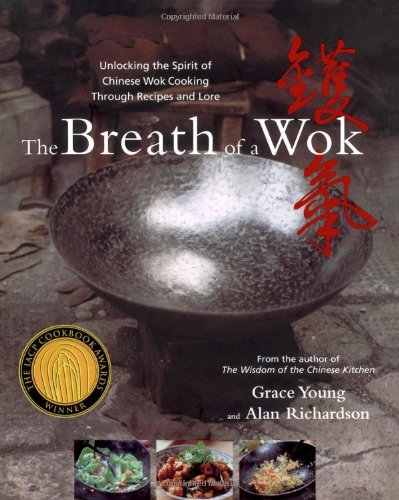
The Breath of a Wok is available on Amazon.
And that’s our take on stir frying and other methods of using a wok. It’s fast, fun and easy, and with a bit of practice you’ll be impressing family and friends in no time with your authentic tasting Asian cuisine. You’ll use it for a a variety of recipes, like for our Sriracha tofu, green bean, and carrot stir-fry, or our lemony chicken quinoa bowls! For the ultimate bible of wok cooking, we highly recommend picking up a copy of The Breath of Wok today.
About Lorna Kring
Recently retired as a costume specialist in the TV and film industry, Lorna now enjoys blogging on contemporary lifestyle themes. A bit daft about the garden, she’s particularly obsessed with organic tomatoes and herbs, and delights in breaking bread with family and friends.



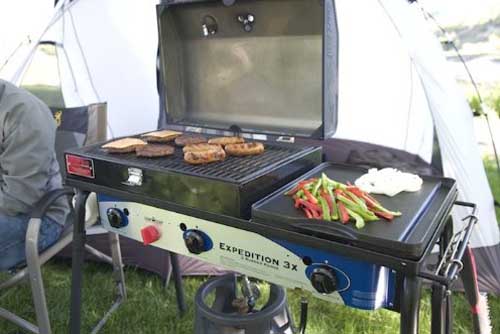

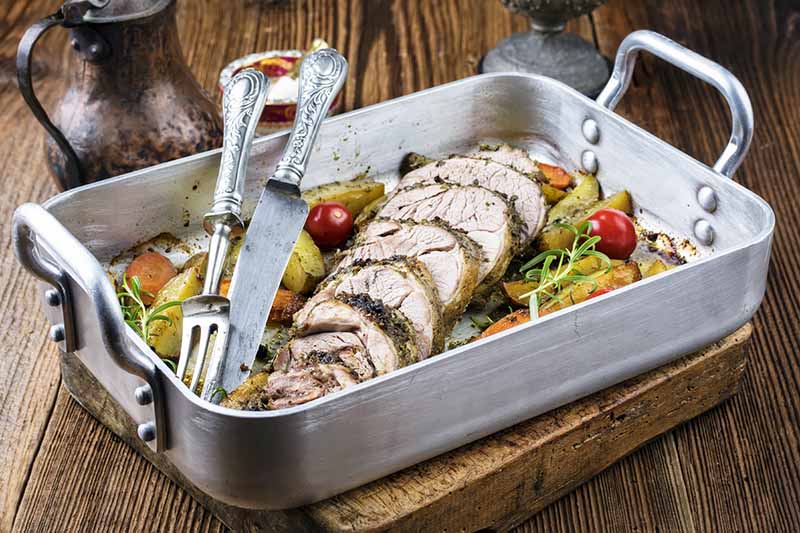

I have one of these, and have been using it for years, but might be interested in upgrading, and I found this article extremely useful. I love how detailed your instructions and description are for seasoning, and the recipes will come in handy. I have never had any tools specifically designed to be used with my wok, so I think I will look into your recommendations for the spatula and steamer.
Glad you enjoyed the post Diane. The spatula is really useful as wooden spoons are too thick to slip under the food, and of course the steam basket delivers wonderfully crisp, nutritious veggies.
I actually really enjoy seasoning utensils like carbon steel and cast iron cookware, somehow it’s a very Zen thing for me, so I enjoy getting into the details – and hopefully others find them useful too!
We own a gigantic version, but I can honestly say that I’m not the best at using it the proper way. Using one the right way requires a little bit more effort than I want to put in, so I tend to stick to more traditional pots and pans out of pure laziness. This is a pretty good guide for using them effectively and getting the desired effect, though. Maybe I’ll take these tips to heart the next time I see ours lying around.
LOL! Well, I’m all for spending time enjoying the food rather than on utensil maintenance. But there’s something about a well-seasoned pan that seems to speak to me…
I agree Zyni, without the needed heat the ingredients seem to steam rather than fry, and it’s a big difference in taste.
Any space to go vertical for your storage? It’s usually an overlooked area in the kitchen…
I’d never even thought to season mine. Mind you, it’s just a standard non-stick affair which I’ve had for years. Maybe now’s the time to upgrade?
Maybe… there’s some pretty nice pans available that I find to be very reasonably priced compared to other cookware.
I don’t have a wok. I would love to have one though. Some things just don’t cook properly without one.
I’ve tried my hand at making various dishes, but you just can’t get a typical pan hot enough to do the job. I definitely need to get one or two at some point. First, I need more kitchen storage. So many kitchen wares, so little storage!
My family used to have one of these, but we got rid of it and I’m pretty sure it was because no one knew how to use it properly. Kind of a shame; that scared me off getting one of my own, when it seems like a great cooking implement for many of my needs. Now that I’ve seen this guide I’m much more encouraged to give it a try. Being able to make my own tempura would be pretty awesome.
Well, a generation or two ago it wasn’t quite as simple to get access to guides or ‘how-to’ material as it is today, and I’d wager a number of utensils like these were disposed of because the owners weren’t sure how to use them. The internet makes it pretty easy to give new techniques a try, like your own awesome tempura!
So, glad you wrote this about the types and what I should be looking for because I am currently in the market for one because my old one is so beat up it’s starting to look cast iron. I love cooking with certain types of oils. I have this hot sesame oil that’s been dying to get used. Pan first. Oil use later.
Oh, good timing! Stay tuned for a review of popular models… you’ll be using that hot sesame oil in no time!
Really appreciate your take on the whole Chinese cuisine, Lorna! I actually was a little surprised seeing “The Breath of a Wok” mentioned in the article, my mother has it and I personally thought that book’s a treasure, haha! Also, I used to steam veggies in a bamboo steamer, it’s the best you can get.
Thanks for your comments, xSentaru, The book is a treasure… and I love the concept of a tool, like a wok, taking on a trait that has to be coaxed out of it by the cook. Very Oriental and mysterious!
I stopped using a wok years ago when mine wore out. I have never invested in another and I think it is time I did so. The stir fries one can do in this type of pan are really delicious and they are quick and easy to make. It is summer here and wok cooking provides the perfect menu!
This is one of my favorite pans for just those reasons om – delicious, quick and easy! Hope you find a good one…
I am not familiar with using a wok…I love Asian food and try to sometimes duplicate recipes at home. Using this type of frying pan seems really easy and my stir fry vegetable may come out a little less mushy if I were to use one of these. It seems so simple and quick..not a lot of oil because you are cooking it quick and fast. A healthy way to cook crisp veggies.
A very healthy way to cook veggies sheebah7. And they really do turn out much crisper than trying to stir fry in a skillet as the walls of the wok give a lot more area to work with.
My mom left me a wok that I have been using for a while now, but I also think it’s time for an upgrade. Whenever I make a dish or when I’m trying to stir fry some vegetables, it just does not get hot enough for me to fry them properly. I love the one I have right now because of sentimental value, but I guess it might be time to let it go.
Oh, that would be a hard one to give up Norma, any chance you can re-purpose it? A planter, Zen pebble garden, candle holder…
All the comments here suggest to me that a lot of food is wasted every day trying to follow advice on how to use stainless steel cookware. This is really good.
Carbon steel is a treat to use Kathy, thanks for your thoughts!
Hi Lorna.
Thanks for the great post, this article looks so great. Actually a wok is a very good cooking utensil, and it best goes with a bamboo steamer when it comes to steaming. Moreover, it does not need to much precaution to use, all you just need to do is to boil water and place the steamer in the wok, make sure the water is not making direct contact with the steamer.
Thanks for the post once again. I really appreciate it.